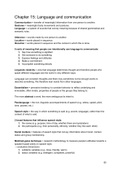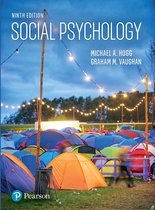Chapter 15: Language and communication
Communication = transfer of meaningful information from one person to another.
Gestures = meaningful body movements and postures.
Language = a system of sounds that convey meaning because of shared grammatical and
semantic rules.
Utterance = sounds made by one person to another.
Locution = words placed in sequence.
Illocution = words placed in sequence and the context in which this is done.
5 sorts of meaning that people can intentionally use language to communicate:
1. Say how something is signified
2. Get someone to do something
3. Express feelings and attitudes
4. Make a commitment
5. Accomplish something directly
Linguistic relativity = view that language determines thought and therefore people who
speak different languages see the world in very different ways.
Language can constrain thoughts and there may sometimes not be enough words to
describe something. We therefore loan words from other languages.
Essentialism = pervasive tendency to consider behavior to reflect underlying and
immutable, often innate, properties of people or the groups they belong to.
The more abstract a word, the more ambiguous its intent is.
Paralanguage = the non–linguistic accompaniments of speech (e.g. stress, speed, pitch,
tone, pauses, etc.)
Speech style = the way in which something is said (e.g. accent, language), rather than the
content of what is said.
2 broad features that influence speech style:
1. the scene (e.g. purpose, time of day, whether there are bystanders)
2. the participants (e.g. their personality, ethnicity, whether they like each other)
Social markers = features of speech style that convey information about mood, context,
status and group membership.
Matched-guise technique = research methodology to measure people’s attitudes towards a
speaker based solely on speech style.
→ evaluative dimensions:
1. solidarity variables (e.g. close, friendly, warm)
2. status variables (e.g. intelligent, competent, powerful)
65






